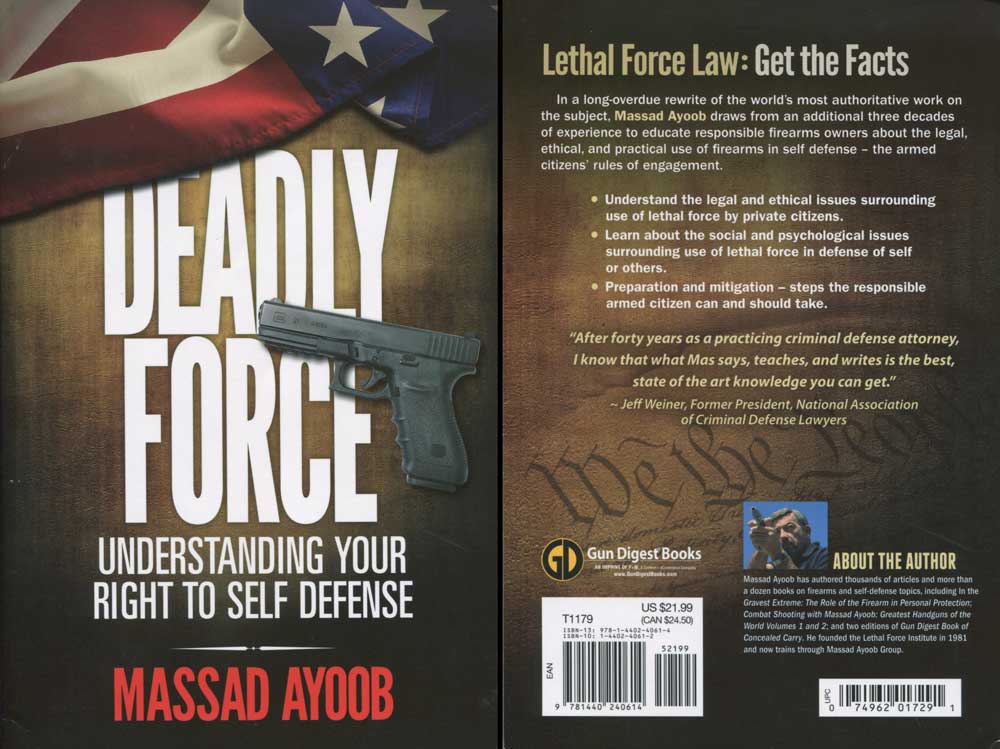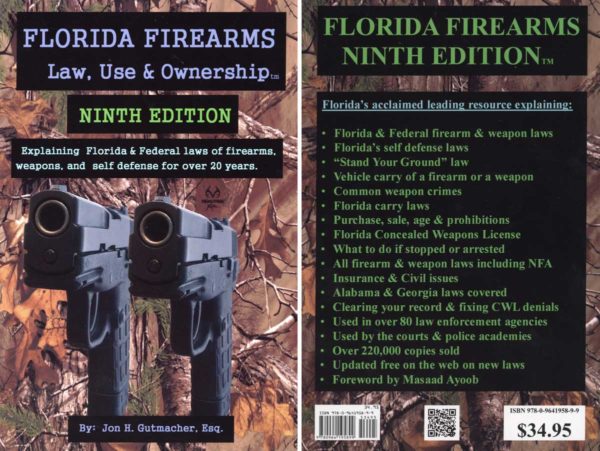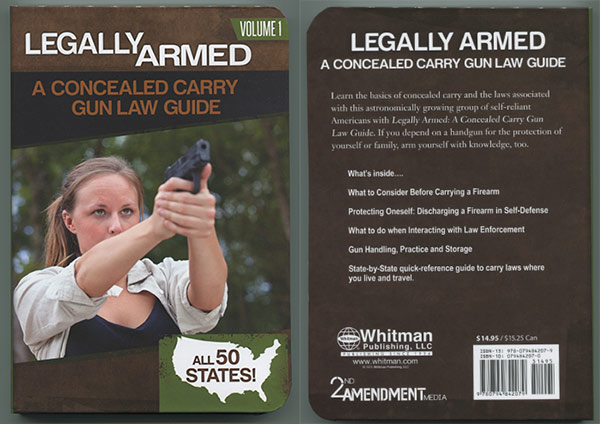[Ed. note: This is a review of the first edition of Legally Armed: A Concealed Carry Gun Law Guide. In my opinion, there were significant problems with the information provided in the text. The company promised to update the information with input from a legal professional. Currently, the company has a fifth edition published, yet prior editions including the one reviewed here are still for sale on Amazon. I urge caution in purchasing this book. If you insist on buying it, I strongly suggest that you get the fifth edition or later for the best chance at getting legally correct and current information.]
Killing another human being in self-defense is not an act to be taken without thoughtful consideration, and it will certainly have legal and emotional consequences. Too many people fail to realize the importance of understanding the laws surrounding the legal carrying of arms and when they can use force to defend themselves.
A handy guide is needed that is easily referenced for accurate legal information and practical advice on working within the complex laws of concealed carry. When I received Legally Armed: A Concealed Carry Gun Law Guide to review, I was hopeful that this book might be a reference I could recommend to readers for that. Unfortunately, it is not.
The book does have merits, but its shortcomings are too large to overcome for me to recommend it at this time. Let’s get into the details…
Organization
Legally Armed is divided into two main sections. The first section consists of eight chapters of information and advice on the general legal aspects of carrying a firearm for self-defense. The second half of the book is devoted to a state-by-state breakdown of specific laws.
Chapters in the first half of the book cover the following topics:
- considerations prior to carrying a firearm;
- interacting with law enforcement;
- general legal terms as they apply to concealed carry;
- justifiable use of force;
- aftermath of a shooting; and
- traveling with a firearm.
I found the chapters were quick reads, and generally had good information. I did take exception with some of the advice on interacting with law enforcement, when to use force and what to do after a shooting. Skip down to the “Problems” section below for additional information on this.
I was pleased to see the book correctly stated that commercial truck drivers can have a firearm in the cab portion of their truck. A myth exists with some in the trucking industry that it is against federal law for a driver to keep a firearm with him or her. While the driver must comply with state laws, there are no federal prohibitions against it.
Legally Armed touches on the carrying of firearms by law enforcement – both active and retired – but fails to identify the appropriate federal law (Law Enforcement Officers Safety Act) or where readers can go to get additional information. I wished the book would have included additional information on LEOSA, as it is a somewhat confusing law.
A note to open carry advocates: Legally Armed generally discourages open carry.
The state-by-state guide highlights key points about the laws in each state including information about shall issue/may issue, restaurant carry, open carry, state park carry and more. Additionally, the contact details are listed for the appropriate state agency for additional information.
The book does not list any specific author. Rather it appears to be a compilation work drawing from a team of researchers and/or writers. It is 184 pages long.
Quality Look and Feel
As with other books from 2nd Amendment Media, Legally Armed has a high-quality cover and good feel. The pages are coated for increased durability, and the print is crisp and black on a white background.
The publisher uses good layout techniques, inserting photos, call-outs and other devices to keep the pages visually interesting. A person skimming the book looking for specific information is likely to locate the needed material quickly.
One thing that I did not like about the layout was the change in font size midway through the book. The early part of the book has a larger typeface that is easy to read. In the state-by-state guide, the font size drops significantly. While more information is packed onto each page, it does become harder to read. People with vision problems may find the type size too small to read comfortably.
Much of the photography was provided by Oleg Volk. If you are not familiar with Volk’s work, he is a pro-gun photographer who has done work for various companies in the firearms industry.
Problems
I identified two major problems in this book:
- questionable advice given, specifically in regards to encounters with law enforcement, justifications in shooting and post-shooting actions; and
- incorrect – or at least imprecise – information in the state-by-state laws section that could result in a reader being charged with a felony.
Let me explain my problems on these two points.
Questionable Advice
Some of the information in the front half of the book is good. Advice on safe gun handling is fine, as is general information on how to obtain a permit for carry. However, several things stuck out to me as being potentially harmful.
Handing a Cop Your Gun
In the section on dealing with law enforcement, some of the information is reasonable. For example, being cordial and cooperative is always a good idea. Even if you are dealing with a bad cop who does stupid things, you will not win any arguments on the street. Also, if you are confrontational, you will look like a problem person in court when the video is played even if you were “right.”
However, there is a portion of the text that tells the reader how to hand a gun to a police officer should the cop ask for it. As a former police officer, I’ve been on both sides of an encounter. Let me emphasize that you should NEVER reach for a gun when stopped by an officer.
If the officer asks you to hand him the gun, I would recommend that you politely explain that you do not want any misunderstandings and that you would be happy to let him retrieve the firearm. If he insists you reach for it, carefully follow his precise directions VERY SLOWLY.
The problem with you reaching for a gun – even when told to do so by the officer who stopped you – is a backup officer who has not heard the primary officer tell you to get the gun will only see you pulling out a pistol. How do you think he will respond?
I would much rather have the book leave out any mention of handing a cop your gun and leave it at “follow the officer’s instructions.” Otherwise, an overeager reader may move a little too fast to hand his pistol over, creating a very unfortunate situation.
When to Draw
According to Legally Armed, “a permit holder should only draw their gun the moment a threat turned deadly and requires lethal force to neutralize.” I disagree.
Consider a man walking toward you with a baseball bat who is threatening to kill you. As he approaches there are certain distances where he would not be able to hit you with the bat, and closer ranges where he could swing and crush your skull. The book would have you wait until skull-bashing distances to draw the gun.
I would argue that it is reasonable to draw your weapon when the credible threat appears (subject is not in swinging range yet, but is armed and threatening) and fire when you are in jeopardy (the armed subject is threatening and is close enough to carry out his threats.) Waiting to draw until the time he can break your head open is not a reasonable action.
Post-Shooting
According to the book, after you’ve shot someone in self-defense, you should:
- secure the scene,
- call the police,
- put the gun down,
- watch the gun,
- gather witnesses, and
- cooperate with police when they arrive.
In theory, the above seems ok. Reality is a far different thing.
In addition to training and research, I’ve actually investigated shootings. They are chaotic environments to say the least.
For some reason, Legally Armed assumes it is safe to place your gun on the ground after you’ve shot the suspect and glanced around to make sure no other criminals are readily visible. Nothing could be farther from the truth. Additional attackers could appear after you’ve placed your gun on the ground, or the attacker may not be completely incapacitated.
Consider this case of an elderly man defending himself and his wife in Florida. The suspect went down with a .38 slug in his face and another in his chest. Thinking the man was dead, the victim called the police and set his gun down, as instructed in this book. The suspect was not completely incapacitated, however. The suspect picked up the victim’s gun and killed him before officers arrived.
Also, consider that bystanders may try to get involved in the scene. In one incident, police officers chased a wanted felon on foot and shot him when the criminal turned to shoot at them. An unruly mob quickly formed and video captured a member of the crowd stealing the suspect’s gun.
In this case, it appeared the thief was making an effort to create the illusion that the officers unjustifiably used force. He could have just as easily used it to shoot the officers distracted by the crowd. What would you do if some bystander took your gun that you placed on the ground?
Cooperating with the police is generally a good thing. However, no mention of your rights is given. Instead, the book states “We hope permit carriers use their firearm with the utmost responsibility and discretion and the police will find their actions above reproach.” That, I think, is also unrealistic and more than a bit irresponsible.
As I’ve stated, shooting scenes are chaotic. Often, things are not clear-cut even when you are completely justified in using force to defend yourself. Hoping that things will turn out for the best is not a strategy I’m willing to bet on.
Friends of the attacker may lie or you might say something in the heat of the moment that sounds like you are the aggressor in the incident. Any number of things can dash that hope on the rocky shoreline of reality.
Skip down to the “Alternatives” section to get a much better source of advice on managing a defensive force encounter and its legal aftermath.
Inaccurate Laws
Without spending many hours of reading and research, I have no way of determining how accurate the interpretation of each state’s laws is.
However, as a resident and former law enforcement officer in Florida, I am familiar with this state’s laws. So, I took a close look at the information presented in that section.
A significant issue right off the bat is where it lists the legality of “unconcealed carry” for permit holders in Florida. The book states “yes.” There is no additional information provided on this topic.
Let me state very clearly: at the time of this writing, it is illegal in the state of Florida to carry a firearm in an open and exposed manner. There are exceptions to this, but they are exceptions, not the rule. Refer to Florida § 790.053 here. Some of the exceptions include inadvertent exposure by someone legally carrying a concealed firearm and during travel to or from a hunting expedition. Refer to Florida § 790.25 for more information in the exceptions here.
It is my opinion that the book should state “no” and then list possible exceptions. By leaving it as an unqualified “yes,” an otherwise law-abiding citizen could be arrested for open carry after relying on the information in Legally Armed.
As I stated above, I do not know how accurate the reporting on the other 49 states’ laws are. However, Legally Armed missed a big one in the Florida section. That causes me a great deal of fear for anyone relying on this book for accurate legal information.
Final Thoughts
I really wanted to like Legally Armed, and there are many aspects about it that I do like. The production quality seems top-notch. Having a small reference book like this, especially for anyone who travels, makes a lot of sense.
However, the critical missteps of incorrect reporting on at least one law and poor advice on carrying and using a firearm make the book something I cannot recommend at this time.
I strongly hope the publisher goes back and updates the book with better information and closer fact-checking. This book has the potential of being something that every gun owner should want. However, it will need a little more work to get it there.
Alternatives
As I said, I hope 2nd Amendment Media updates this book to make it a more reliable reference. Until then, I suggest several alternatives.

For self-defense law, knowing when to shoot and what to do if you are involved in a self-defense shooting, I highly recommend buying Massad Ayoob’s Deadly Force: Understanding Your Right to Self Defense book. There is no greater expert in the use of a citizen’s right to self-defense than Ayoob, and this tome should be mandatory reading for anyone who is considering the carry of a firearm for protection. Watch for a review of this book coming soon on the site.
If you are looking for gun laws specific to your state, I suggest two sources. The first is the online state gun law guide offered by the National Rifle Association’s Institute for Legislative Action (NRA-ILA). While it does not offer advice or significant interpretation of the laws, it is free.

The second source for Florida residents is very trusted and up-to-date: suggest that you get the ninth edition (or more current) by Jon H. Gutmacher. I own this book (and prior editions.) I’ve found it to be an authoritative text on Florida gun laws. Gutmacher is a long-time Florida attorney and consultant who has an extensive background in self-defense and firearms cases.
There are other state-specific gun law books on the market. A quick check of Amazon, turns up a few. However, I’ve not read any of the other state books, so I cannot vouch for their accuracy.
Check out these and other tomes on my gun book review page.
Epilogue
I initially wrote this review in February of 2015. Because of the significant issues I found with the book, I e-mailed the company and expressed my concerns. I was contacted by the General Manager for 2nd Amendment Media by phone.
I was told that Legally Armed was a guide that was intended to be updated annually, and that the new edition was close to publication. It was my understanding that the new book was expected to be available by May 2015. The manager took careful note of my exceptions and advised that the company had a legal expert that would be reviewing the state law information.
Since a new edition was so close to publication, I delayed the publication of this review. I had hoped the new edition would correct all of the problems I found in the book, and I would be able to recommend it to you, my readers.
I did not receive an updated edition of Legally Armed by the end of May, so I reached out to 2nd Amendment Media to see where things stood. A company representative informed me that the company may not publish any of its scheduled titles in 2015. So, as it stands now, there are no specific dates when – if at all – an updated version of this book will be published.
The existing book is, however, still being offered for sale at Amazon and other locations. This is, in my opinion, highly irresponsible.
Last update – July 29, 2021.
Disclosure
As I emphasize with all of my reviews, I write these for you – the reader. I’ve spent far too much time and money on bad gear, bad books and bad training in my life, and I would like to spare you the same wasted investments.
Legally Armed was provided to me by 2nd Amendment Media, a division of Whitman Publishing LLC. The company has provided me with copies of all of its gun related books for review here on the site. No monies were exchanged, nor any promises made to offer positive reviews of the products. Hopefully, you can see in the above review that I indicate both the good aspects of the book and where I see significant shortcomings.
GunsHolstersAndGear.com is a for-profit website. I do not charge readers a dime to access the information I provide.
Some of the links on this page and site are affiliate links to companies like Amazon and Palmetto State Armory. These links take you to the products mentioned in the article. Should you decide to purchase something from one of those companies, I make a small commission.
The links do not change your purchase price. I do not get to see what any individual purchases.
